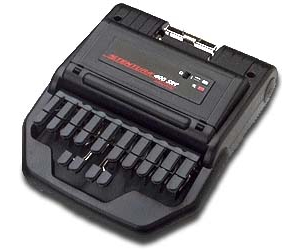What's That Machine Court Reporters Use?
Here is the meaning of each key on a shorthand machine:

Modern stenotypes have two rows of consonants across the middle, underneath a long "number bar." Set in front of these are four vowel keys: A O E and U. Some letters of the alphabet are repeated twice and many other letters are not there at all. Combinations of keys are used to represent the remaining letters.
How does it work? Court stenographers can type entire words all at once by striking multiple keys at the same time. The left hand spells out the beginning of a syllable, while the right hand spells out the end; all keys are pressed at the same time. It takes no longer to strike four keys together than it takes to strike one. The machine produces an alphabet soup that’s incomprehensible to anyone who’s not trained in machine shorthand. The keyboard is very compact with little hand motion required from side to side.
All shorthand methods are phonetic to some degree, but there aren’t enough keys on each side of the keyboard to cover every sound. Although it is possible to spell words out with this machine, the stenographer is taught to listen to the sound of the words and break them up into syllables. There is generally one "stroke" (downward motion of the hands) for each syllable in the word or phrase.
Each key prints in a fixed location on the paper, in this order:
S T K P W H R A O * E U F R P B L G T S D Z
Compare this to the picture of the keyboard and you will see that all of the consonants on the "initial" side of the keyboard print before any of the vowels, and that all of the consonants on the "final" side print after the vowels. As a consequence, the stenographer thinks from left to right (from initial side to final side) when selecting keys on the keyboard. Certain combinations of adjacent keys correspond to the missing consonants: For example, there’s no "M" anywhere on the keyboard, so you have to press "P" and "H" together to start syllables with that sound. There is a "B" on the right side of the board, but none on the left - that means it’s easy to end a syllable with "B," but for words that begin with "B" you need to hit "P" and "W" together.
A period is denoted by striking the four-key combination FPLT on the upper right bank. A comma is signaled by RBGS on the lower right bank, just below the keys used to make the period.
Many abbreviations are used, both for single words and phrases. Every reporter builds up quite a stock of these over the years, just as you would taking notes by hand in a lecture. Each court reporter might use different combinations to represent homonyms or other ambiguous words. At court reporting school, you can learn one of at least half a dozen machine shorthand "theories," which teach different approaches and general rules. But any experienced stenographer will work out his/her own abbreviations, especially for words and phrases particular to a given job. Here are some of the more common ones:
| Meaning | Stroke |
| state your name | STURPB |
| have you ever | SRUFR |
| it | T (on the initial side) |
| the | T (on the final side) |
Numbers can be printed by using the number bar. When the number bar is struck at the same time as the "H" key, the numeral 4 is printed. See the diagram above for the placement of the other number combinations.
The items mentioned here are just a small sample of all there is to know about machine shorthand. Hopefully, this will at least give you some idea what the reporter is doing with "that little machine."
ANATOMY OF A SHORTHAND REPORTER
Technically, the dictionary describes a shorthand reporter as a court reporter, law reporter, etc.
Shorthand reporters come in all sizes, weights, ages and shapes; but they all have the same creed: The show must go on.
They can be found in trials, hearings, depositions, conventions, arbitrations, behind computer screens, over dictation equipment, and under piles of papers.
Their spouses tolerate them, try to understand them, don’t disturb them when they are busy, and don’t believe they are as busy as they say they are.
They are misunderstood by IRS, attorneys, spouses, children, friends, county commissioners, clerks, janitors, bailiffs and the post office.
They travel the world; may of them. The shorthand reporter is a dictionary with two legs. They have to love words and have an excellent memory. They like coffee, recesses, ACRA seminars and conventions, other reporters, paychecks, dependable scopists, computers and living in their history-making world.
They dislike tongue-tied, stuttering, lisping witnesses, juvenile court hearings and witnesses who talk when someone else is talking.
A shorthand reporter’s car is an office on wheels.
I am sure there is a special place in heaven for reporters where notes are perfect and transcript deadlines are in the future instead of now; where there will be time to talk to old friends or read a book or get caught up on their sleep. But, first, they have to find time between transcripts to go there.

